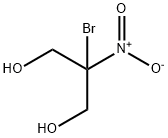10-Bromodecanol
Synonym(s):Decamethylene bromohydrin
- CAS NO.:53463-68-6
- Empirical Formula: C10H21BrO
- Molecular Weight: 237.18
- MDL number: MFCD00041681
- EINECS: 258-572-4
- SAFETY DATA SHEET (SDS)
- Update Date: 2024-12-18 14:07:02

What is 10-Bromodecanol?
Chemical properties
Clear yellow liquid
The Uses of 10-Bromodecanol
10-Bromodecanol can be used to synthesize rotaxane dendrimers. It can also be used to synthesize J2326, a molecule that induces neurite outgrowth in neuronal cells.
The Uses of 10-Bromodecanol
10-Bromo-1-decanol is used as an important raw material and intermediate used in organic Synthesis, pharmaceuticals, agrochemicals and dyestuff. It was also used in the synthesis of (11Z,13Z)-11,13-hexadecadienal, the female sex pheromone of the navel orangeworm (Amyelois transitella).
Definition
ChEBI: 10-Bromo-1-decanol is a primary alcohol.
Properties of 10-Bromodecanol
| Boiling point: | 165-169 °C/10 mmHg (lit.) |
| Density | 1.19 g/mL at 25 °C (lit.) |
| refractive index | n |
| Flash point: | >230 °F |
| storage temp. | Inert atmosphere,Store in freezer, under -20°C |
| solubility | Chloroform (Sparingly) |
| pka | 15.20±0.10(Predicted) |
| form | Liquid |
| color | Clear yellow |
| Water Solubility | It is miscible with water. |
| BRN | 1738593 |
| Stability: | Moisture Sensitive |
| CAS DataBase Reference | 53463-68-6(CAS DataBase Reference) |
| EPA Substance Registry System | 1-Decanol, 10-bromo- (53463-68-6) |
Safety information for 10-Bromodecanol
| Signal word | Warning |
| Pictogram(s) |
 Exclamation Mark Irritant GHS07 |
| GHS Hazard Statements |
H315:Skin corrosion/irritation H319:Serious eye damage/eye irritation H335:Specific target organ toxicity, single exposure;Respiratory tract irritation |
| Precautionary Statement Codes |
P261:Avoid breathing dust/fume/gas/mist/vapours/spray. P264:Wash hands thoroughly after handling. P264:Wash skin thouroughly after handling. P271:Use only outdoors or in a well-ventilated area. P280:Wear protective gloves/protective clothing/eye protection/face protection. P302+P352:IF ON SKIN: wash with plenty of soap and water. P305+P351+P338:IF IN EYES: Rinse cautiously with water for several minutes. Remove contact lenses, if present and easy to do. Continuerinsing. |
Computed Descriptors for 10-Bromodecanol
| InChIKey | LGZMUUBPTDRQQM-UHFFFAOYSA-N |
New Products
(S)-3-Aminobutanenitrile hydrochloride 4-Methylphenylacetic acid N-Boc-D-alaninol N-BOC-D/L-ALANINOL Tert-butyl bis(2-chloroethyl)carbamate 3-Morpholino-1-(4-nitrophenyl)-5,6-dihydropyridin- 2(1H)-one Furan-2,5-Dicarboxylic Acid Tropic acid 1-Bromo-3,5-Di-Tert-Butylbenzene S-2-CHLORO PROPIONIC ACID ETHYL ISOCYANOACETATE 2-Bromo-1,3-Bis(Dimethylamino)Trimethinium Hexafluorophosphate 4-IODO BENZOIC ACID 3-NITRO-2-METHYL ANILINE 1-(2,4-DICHLOROPHENYL) ETHANAMINE (2-Hydroxyphenyl)acetonitrile 4-Bromopyrazole 2-(Cyanocyclohexyl)acetic acid 4-methoxy-3,5-dinitropyridine 1-(4-(aminomethyl)benzyl)urea hydrochloride 2-aminopropyl benzoate hydrochloride diethyl 2-(2-((tertbutoxycarbonyl)amino) ethyl)malonate tert-butyl 4- (ureidomethyl)benzylcarbamate Ethyl-2-chloro((4-methoxyphenyl)hydrazono)acetateRelated products of tetrahydrofuran




![METHYL 2-BROMO-2-[3-(1-BROMO-2-METHOXY-2-OXOETHYL)-1-ADAMANTYL]ACETATE](https://img.chemicalbook.in/StructureFile/ChemBookStructure2/GIF/CB9125351.gif)

![1-(16-BROMO-3,17-DIHYDROXY-10,13-DIMETHYL-2,3,4,7,8,9,10,11,12,13,14,15,16,17-TETRADECAHYDRO-1H-CYCLOPENTA[A]PHENANTHREN-17-YL)ETHAN-1-ONE](https://img.chemicalbook.in/StructureFile/ChemBookStructure2/GIF/CB1267103.gif)

You may like
-
 10-Bromo-1-decanol CAS 53463-68-6View Details
10-Bromo-1-decanol CAS 53463-68-6View Details
53463-68-6 -
 2033-24-1 98%View Details
2033-24-1 98%View Details
2033-24-1 -
 1975-50-4 98%View Details
1975-50-4 98%View Details
1975-50-4 -
 2-HYDROXY BENZYL ALCOHOL 98%View Details
2-HYDROXY BENZYL ALCOHOL 98%View Details
90-01-7 -
 2-Chloro-1,3-Bis(Dimethylamino)Trimethinium Hexafluorophosphate 221615-75-4 98%View Details
2-Chloro-1,3-Bis(Dimethylamino)Trimethinium Hexafluorophosphate 221615-75-4 98%View Details
221615-75-4 -
 61397-56-6 CIS BROMO BENZOATE 98%View Details
61397-56-6 CIS BROMO BENZOATE 98%View Details
61397-56-6 -
 14714-50-2 (2-Hydroxyphenyl)acetonitrile 98+View Details
14714-50-2 (2-Hydroxyphenyl)acetonitrile 98+View Details
14714-50-2 -
 118753-70-1 98+View Details
118753-70-1 98+View Details
118753-70-1
Statement: All products displayed on this website are only used for non medical purposes such as industrial applications or scientific research, and cannot be used for clinical diagnosis or treatment of humans or animals. They are not medicinal or edible.